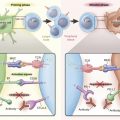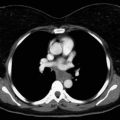Summary of Key Points
- •
Up to 25% of patients with stage I nonsmall cell lung cancer are considered medically inoperable or high risk for surgery.
- •
Therapies such as stereotactic body radiation therapy or ablation offer a less invasive alternative to surgery for marginally resectable patients.
- •
Guidelines have been developed to determine fitness for lung cancer surgery (see text).
- •
Guidelines to determine optimal therapy (e.g., surgery vs. stereotactic body radiation therapy/ablation) are not well established.
- •
The American College of Chest Physicians has determined that patients with a forced expiratory volume in 1 second or percentage of lung diffusion capacity for carbon monoxide less than 40% are at an increased risk for resection.
- •
The American College of Surgeons Oncology Group has defined criteria for patients considered to be high-risk for lobectomy but who are still candidates for sublobar resection or nonoperative therapy.
- •
Resection is still feasible in such patients defined as high risk.
- •
Sublobar resection can be undertaken with low mortality by experienced surgeons.
- •
Sublobar resection does not result in significant declines in pulmonary function in high-risk patients.
- •
Evaluation in a multidisciplinary setting that includes an experienced thoracic surgeon is recommended when determining therapy for marginally resectable patients.
The standard treatment of stage I nonsmall cell lung cancer (NSCLC) is lobectomy with systematic node dissection. Unfortunately, up to 25% of patients with stage I NSCLC are considered to be medically inoperable or are at high risk for surgery. The increasing use of computed tomography (CT) screening often results in the detection of small tumors. This increase in the number of people with small tumors raises the following question: “What is the appropriate extent of pulmonary resection, particularly in older patients or in patients who, for other reasons, have marginally resectable disease?” The role of sublobar resection is further challenged by the introduction of new techniques associated with low rates of mortality and morbidity, such as stereotactic ablative radiotherapy (SABR) and radiofrequency ablation (RFA).
Which Patients are Considered Marginally Resectable?
Respiratory failure and pulmonary complications represent the most substantial risks following lung resection, and preprocedure risk assessment is based primarily on pulmonary function. Algorithms for differentiating risk levels for patients who are candidates for lung resection have been published. These guidelines provide general cutoffs for additional assessment and suggest threshold values to differentiate low-risk patients from high-risk patients. Cardiac evaluation and lung function testing—including lung diffusion capacity for carbon monoxide (DLCO)—are recommended for every patient who is to have pulmonary resection. Most centers use predictive postoperative forced expiratory volume in 1 second (FEV 1 ) and DLCO. If both values are higher than 30%, resection may still be feasible. According to the American College of Chest Physicians guidelines on the physiologic evaluation of patients for pulmonary resection, patients with an estimated postoperative FEV 1 or DLCO of less than 40% are considered to be at increased risk for postoperative complications. The American College of Surgeons Oncology Group (ACOSOG) has initiated two studies in high-risk patients who have had sublobar resection and patients who are medically inoperable and are treated with RFA. Although the same physiologic criteria were used for both studies ( Table 33.1 ), an important factor was that a credentialed surgeon evaluated patients and deemed each patient to be either a poor candidate for lobectomy but a candidate for a more limited resection or a potential candidate for RFA because the patient was medically inoperable. Criteria that define marginally resectable as contrasted with unresectable are not standardized, and clinical evaluation by an experienced surgeon is essential. Ideally, the cases of all patients who are considered to have marginally resectable disease should be reviewed at a multidisciplinary meeting with an experienced thoracic surgeon participating in the discussion. In some cases of heterogeneous emphysema, pulmonary function may even improve after resection when the tumor is in the most emphysematous zone. This improvement is demonstrated by the results of lung volume–reduction surgery, and patients with this type of disease should not be denied the benefits of a curative lung resection.
| Major Criteria | Minor Criteria |
|---|---|
| FEV 1 ≤50% | FEV 1 , 51% to 60% |
| DLCO ≤50% | DLCO, 51% to 60% |
| Age ≥75 years | |
| Pulmonary hypertension (defined as pulmonary artery systolic pressure >40 mmHg) | |
| Poor left ventricular function (defined as an ejection fraction ≤40%) | |
| Resting or exercise arterial pO 2 ≤55 mmHg or SpO 2 ≤88% | |
| pCO 2 >45mmHg | |
| Modified Medical Research Council Dyspnea Scale score ≥3 |
a Eligible patients had to meet one major criterion or two minor criteria.
It is difficult to know how many patients with stage I NSCLC are considered marginally resectable; however, we can get an estimate from some large database studies, such as those using data from the Surveillance, Epidemiology, and End Results (SEER) database. In one study involving 14,555 patients with stage I and II lung cancer, approximately 30% of patients aged 75 years or older were not offered surgery, compared with 8% of patients younger than 65 years. It is unclear how many of these patients were not surgical candidates, and how many, if evaluated by an experienced surgeon, would have been offered sublobar resection. In another analysis of data from the SEER database, 10,761 patients with stage IA NSCLC had resection, with sublobar resection performed in 2234 (20.7%) of these patients.
Role of Sublobar Resection in the Treatment of Nonsmall Cell Lung Cancer
The use of segmentectomy for treatment of lung cancer was initially described in 1973, when Jensik et al. reported on patients who had segmental resection for lung cancer, thereby questioning the standard of lobectomy at that time. The only prospective study comparing sublobar resection with lobar resection for the treatment of NSCLC is the Lung Cancer Study Group (LCSG) trial. In this study, 122 patients were randomly assigned to limited resection (segmentectomy [67%] or wedge resection) and 125 patients to lobectomy. A threefold increase in local recurrence was associated with lobectomy, as was a trend suggesting a survival benefit ( p = 0.088). Since the early 2000s, a large body of literature consisting of single-institution studies has demonstrated equivalent rates of regional recurrence and survival for segmentectomy and lobectomy for small (≤2 cm) node-negative tumors. In an effort to increase the level of evidence to support limited resection for these small tumors, two prospective randomized studies are ongoing: one in the United States and Canada, with an expected enrollment of 1258 patients over 5 years (CALGB 140503; ClinicalTrials.gov identifier: NCT00499330); and the other in Japan, with an accrual of 1100 patients over 3 years (JCOG0802/WJOG4607L). Inclusion criteria in both trials are peripheral small (≤2.0 cm) NSCLC, excluding noninvasive lung cancer on CT (pure ground-glass opacity [GGO]). Until the data in these ongoing randomized trials are mature, it is recommended that, for standard-risk patients with operable disease, anatomic segmentectomy should be reserved for pure GGO lesions or partly solid lesions (<25%) smaller than 2 cm, located in the peripheral third of the lung. These pure GGO lesions are known to be noninvasive and are associated with no spread to the nodes. When segmentectomy is performed, the tumor should be situated in the central aspect of a typical pulmonary segment and the T1a N0 M0 status should be confirmed by examination of an intraoperative frozen section of N1 and N2 nodes. In addition, the surgeon should always resect all intersegmental lymph nodes to ensure they are tumor free. Otherwise, the procedure should be converted to a lobectomy. In patients considered marginally resectable, sublobar resection can be performed more liberally. To decrease rates of local recurrence, this procedure is combined with intraoperative brachytherapy at some centers.
Sublobar resection can be performed by anatomic segmentectomy or wedge resection. In the case of wedge resection, the intersegmental and interlobar lymph nodes are usually not removed, and the margin between the staple line and the tumor is more likely to be smaller, especially in central lesions. In the LCSG trial, segmentectomy was associated with a decreased risk of recurrence in the involved lobe compared with wedge resection. The superiority of segmentectomy over wedge resection for non-GGO lesions has been demonstrated in multiple studies. In one study of SEER data for patients with stage IA NSCLC, the survival associated with segmentectomy was compared with the survival associated with wedge resection. After adjusting for propensity scores, overall and lung cancer-specific survival rates were significantly better after segmentectomy (hazard ratio, 0.80 [95% confidence interval, 0.69–0.93] and hazard ratio, 0.72 [95% confidence interval, 0.59–0.88], respectively).
Impact of Sublobar Resection On Lung Function and Morbidity
In the LCSG trial, pulmonary function tests were measured preoperatively and at 6-month intervals. At 6 months, the changes from baseline for FEV 1 , forced vital capacity, and maximum voluntary ventilation were significantly better in patients who had sublobar resection than in patients who had lobar resection. At 12 months to 18 months, only the FEV 1 was significantly better for patients who had sublobar resection compared with lobectomy. DLCO was not routinely measured in the LCSG trial. Keenan et al. analyzed pulmonary function tests from 147 patients who underwent lobectomy and 54 patients who underwent segmentectomy. One year after lobectomy, there were significant decreases from the preoperative values for forced vital capacity, FEV 1 , maximal voluntary ventilation, and DLCO capacity in patients who received lobectomy. However, the lung volume did not change substantially after segmentectomy. The only significant change after segmentectomy was in DLCO. The preoperative pulmonary function in patients who underwent segmentectomy was significantly reduced compared with that in patients who underwent lobectomy (FEV 1 , 75.1% vs. 55.3%; p < 0.001). A 2009 study demonstrated that a substantial decline in postoperative function after lung resection is less likely among patients with low FEV 1 . In this study, investigators compared the outcomes for patients older than 75 years with stage I NSCLC who received segmentectomy (78 patients) or lobectomy (106 patients). The 30-day operative mortality rate was 1.3% for segmentectomy and 4.7% for lobectomy. Patients who received segmentectomy had fewer major complications (11.5% vs. 25.5%; p = 0.02). The 5-year overall and disease-free survival rates were equivalent.
The role of brachytherapy in marginally resectable (≤3 cm) stage I NSCLC treated by sublobar resection was evaluated in a multicenter randomized trial (Z4032). In a preliminary report from this trial, multivariable regression analysis showed no significant impact of brachytherapy, video-assisted thoracoscopic surgery (VATS), or thoracotomy on 3-month FEV 1 , DLCO, or dyspnea score. A 10% change in FEV 1 or DLCO was regarded as clinically meaningful. The FEV 1 decreased by 10% in 22% of patients who received sublobar resection of the lower lobe compared with 9% of patients who received sublobar resection of the upper lobe ( p = 0.04; odds ratio, 2.79). An updated analysis of this study was recently reported. Pulmonary function tests were obtained at baseline, 3 months, 12 months, and 24 months after therapy. This updated analysis only included 69 patients who had measurement at all four time points. The median change from baseline for FEV 1 % was +2%, +1%, and +1% at 3 months, 12 months, and 24 months, respectively. The median change from baseline for DLCO% was –1%, –2%, and –2% at the same time points, respectively. A decline of 10% or more was seen after lower lobe resections at 3 months, but was not seen at 12 months or 24 months. A decline of 10% or more in DLCO was seen after thoracotomy at 3 months but not at 12 months or 24 months.
This trial also demonstrated that sublobar resection was associated with a 30-day and 90-day mortality of 1.4% and 2.7%, respectively. Grade 3 or higher complications occurred in 27.9% of patients. Segmental resections were more likely to be associated with grade 3 or higher adverse events (41.5%) compared with wedge resections (29.7%). DLCO less than the median of 46% was also associated with a greater risk of grade 3 or higher toxicity.
A recent study evaluated the ACOSOG criteria in 490 stage I lung cancer patients undergoing resection at their institution. Patients were divided into high risk and low risk based on the inclusion criteria from Z4032, with 180/490 patients defined as high risk. No differences in postoperative mortality were seen between high-risk and standard-risk patients, however, length of stay was longer in the high-risk groups. Major (15.6% vs. 6.7%) and minor (48.3% vs. 22.3%) morbidity were also significantly increased in the high-risk groups. Three-year survival was 59% for high-risk and 76% for standard-risk patients. This study not only supports the classification used in the ACOSOG studies, but also underscores the continued role of surgery for these patients with no differences in mortality and acceptable 3-year survival.
Stay updated, free articles. Join our Telegram channel

Full access? Get Clinical Tree







